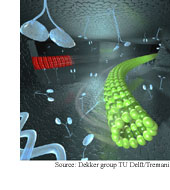|
NEWS
|
Molecular
traffic control
 A biochip sorts
molecules by using an electric field to push microtubules
into one branch or the other of a Y junction. The technique
could be used to transport substances at the molecular
level in biochips and for assembling nanoscale devices.
(Molecular Sorting by Electrical Steering of Microtubules
in Kinesin-Coated Channels, Science, May 12, 2006)
A biochip sorts
molecules by using an electric field to push microtubules
into one branch or the other of a Y junction. The technique
could be used to transport substances at the molecular
level in biochips and for assembling nanoscale devices.
(Molecular Sorting by Electrical Steering of Microtubules
in Kinesin-Coated Channels, Science, May 12, 2006)
DNA tweezer machine
A molecular machine uses DNA
tweezers on a DNA track to join a pair of molecules
so they form a new molecule. The technique allows for
close control of chemical reactions, which is key to producing
new substances and studying biomolecular interactions.
(Addressable Molecular Tweezers for DNA-Templated Coupling
Reactions, Nano Letters, May 10, 2006)
Tricks of light
Two teams of scientists have produced materials
that cause the peaks of light pulses fired into them to
travel backwards, though the pulses as a whole always
travel forward. The research could lead to faster optical
communications systems. (Observation of Backward Pulse
Propagation Through a Medium with a Negative Group Velocity,
Science, May 12, 2006)
Nanotube LEDs
Thin, transparent sheets of carbon nanotubes
make flexible electrodes for organic light-emitting
diodes, which improves the devices' durability. Light-emitting
diodes with nanotube electrodes could be used for flexible
displays that can handle a real-world use. (Carbon nanotube
sheets as electrodes in organic light-emitting diodes,
Applied Physics Letters, May 1, 2006)
Nanowires stand tall
Field effect transistors made with vertical
silicon nanowires perform as well as transistors made
with horizontal silicon nanowires. Vertical nanowires
allow more transistors to be packed in the same space,
opening a route to faster computer chips. (Silicon Vertically
Integrated Nanowire Field Effect Transistors, Nano
Letters, May 10, 2006)
Superconductor etch-a-sketch
A way of switching special metal oxides from superconducting
to normal conductivity allows researchers to write
superconducting features like lines and dots into
films of the materials. The method could be used to make
superconducting circuits and devices for scientific instruments,
and prototype quantum computers. (Local Switching of Two-dimensional
Superconductivity Using the Ferroelectric Field Effect,
Nature, May 11, 2006) |
FEATURES
|
View
from the High Ground: Cornell's Jon Kleinberg
Six degrees of separation, buying gasoline
by the molecule, the science of popularity, all just getting
along online, intellectual prosthetics, Big Science, making
up questions, and telling stories.
|
How
It Works: Quantum computing: qubits
Photons, electrons and atoms, oh my! These particles are
the raw materials for qubits, the basic building blocks
of quantum computers. |
|
 |
News RSS feed 
Blog RSS feed 
Bookshelf RSS feed

New: TRN's
Internet Services
TRN's Jobs Center
|
| |
|
| |
|
| |
"In
most areas of science and technology, the origins
of new breakthroughs can still be found in the work
of a small number of people -- or even a single
person -- working at their own pace on their own
questions, pursuing things that interest them. "
- Jon Kleinberg, Cornell University |
|
| |
|
| |
Thanks
to Kevin from
GoldBamboo.com
for technical support |
|

